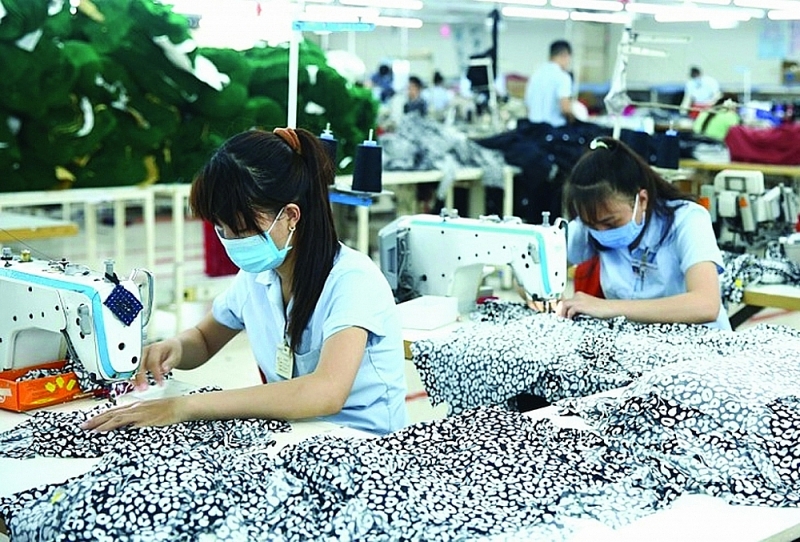Two big strategies for textile enterprises in the post-Covid-19 period
In the post-Covid-19 development strategy of Vietnamese textile and garment enterprises,
 |
|
"Greening" the textile industry is a common trend, forcing businesses to respond if they want to participate in the global textile supply chain. Photo: ST |
“Greening” the production process
With a series of Free Trade Agreements (FTAs) signed by Vietnam, Vietnamese textile and garment firms have many competitive opportunities in markets, thereby opening up huge export opportunities for Vietnam's textile and garment industry.
However, it comes with stricter requirements for product quality. For example, in the EU market, Mr. Pham Van Viet, Vice Chairman of Ho Chi Minh City Textile and Apparel Association, Chairman of the Board of Directors Viet Thang Jean, said that, in addition to the requirements of corporate social responsibility, garment products also have to ensure environmental friendliness.
Accordingly, businesses must use green, clean and sustainable technology.
Mr. James Phillips, General Director of TAL Vietnam Garment Company, said that more than 250 fashion brands have set standards and codes of conduct for environmentally responsible behavior with suppliers. Specifically, Vietnamese textile and garment enterprises supplying and processing for these brands must carry out production in the direction of "greening" effectively and profitably.
The factory must save energy, save water, use environmentally friendly and safe materials. For enterprises that cause pollution in the production process, do not apply solutions to save energy and resources, there is a risk of losing orders.
"Greening" the textile industry has now become a global trend, so businesses have no choice to improve and implement these models. Mr. Tran Nhu Tung, Head of the Sustainable Development Department of the Vietnam Textile and Apparel Association, also said that most of the enterprises in the supply chain of the textile and garment industry that process for major brands have received requests for “greening" production activities. This is one of the basic requirements for factories participating in the supply chain.
Facing increasingly strict requirements of brands, many large textile enterprises have made efforts to innovate technology to be able to survive.
For example, Viet Thang Jean has invested in laser technology instead of traditional bleaching, helping to reduce the number of employees from fifty people to only one. Along with that, the entire factory has a rooftop solar power system, so the electricity demand for production only needs to be partially supplemented. In addition, Viet Thang Jean also invests in nano dyeing equipment, ozone removal technology to increase productivity and save energy.
Responding quickly to the requirements of "greening" will help textile enterprises increase orders and expand international markets. However, this is a huge challenge for small and medium sized enterprises due to limit ed financial resources.
Mr. Pham Van Viet suggested the State should have a more open mechanism in developing supporting industries for the textile and garment industry and change the approach of banks. Because of the current lending criteria, businesses cannot access capital to invest in renewing machinery and technology.
Mr. Nguyen Quyet Thang, Deputy General Director of Corporation 28 (Agtex 28), also said that, in response to customers' requests to meet the green production process, in the development strategy, Agtex will focus on resources to fulfill these requirements. Accordingly, Agtex 28 will invest in equipment to replace workers, save energy, use environment-friendly devices, circulating water sources, and building a green, clean and environmentally production environment.
Bringing Vietnamese textile and garment brands to the international market
In taking advantage of the FTAs to which Vietnam is a member, in addition to efforts to meet the requirements to retain brands, textile and garment enterprises also cherish larger ambitions to be able to export garment products with high prices. "How Vietnamese brands like V-Sixtyfour of Viet Thang Jean or Belluni of Agtex 28 can be exported to the world market is a concern and effort of enterprises," Mr. Thang said.
According to experts, many Vietnamese enterprises are now able to make good quality products to meet the strict requirements of other countries. But in order to be accepted by consumers, it is necessary to focus on investing in branding, market research and marketing.
"In order to realize Agtex 28's desire to bring the Belluni brand to the international market, we are negotiating with a number of corporations to find a solution," Mr. Thang said.
Accordingly, for the EU market, in addition to meeting the requirements of clean and green production, social responsibility for employees, it is also necessary to have an office in the EU for marketing.
However, in the past two years, trade promotion has been interrupted due to the impact of the Covid-19 pandemic. The situation is basically under control, businesses hope that the Ministry of Industry and Trade will soon restart trade promotion programs to support businesses to access the market and bring pure Vietnamese products to the international market.
Sharing the same opinion with Mr. Thang, Mr. Pham Van Viet, as leader of the Ho Chi Minh City Textile and Apparel Association, proposed that Ho Chi Minh City allow the association to establish a center for the textile and garment industry with four functions: human resource training; introduction of raw materials; sales, product introduction and display, exhibition of collections of the textile industry in Vietnam.
According to Mr. Viet, in the textile industry, the stage that brings the greatest added value is the design and branding stage. As for the steps from cotton, yarn, washing, sewing, etc., they add up to only 40% of the total product cost.
Accordingly, the Ho Chi Minh City Textile and Apparel Association will cooperate with the EU to train designers for Vietnam's textile industry.










